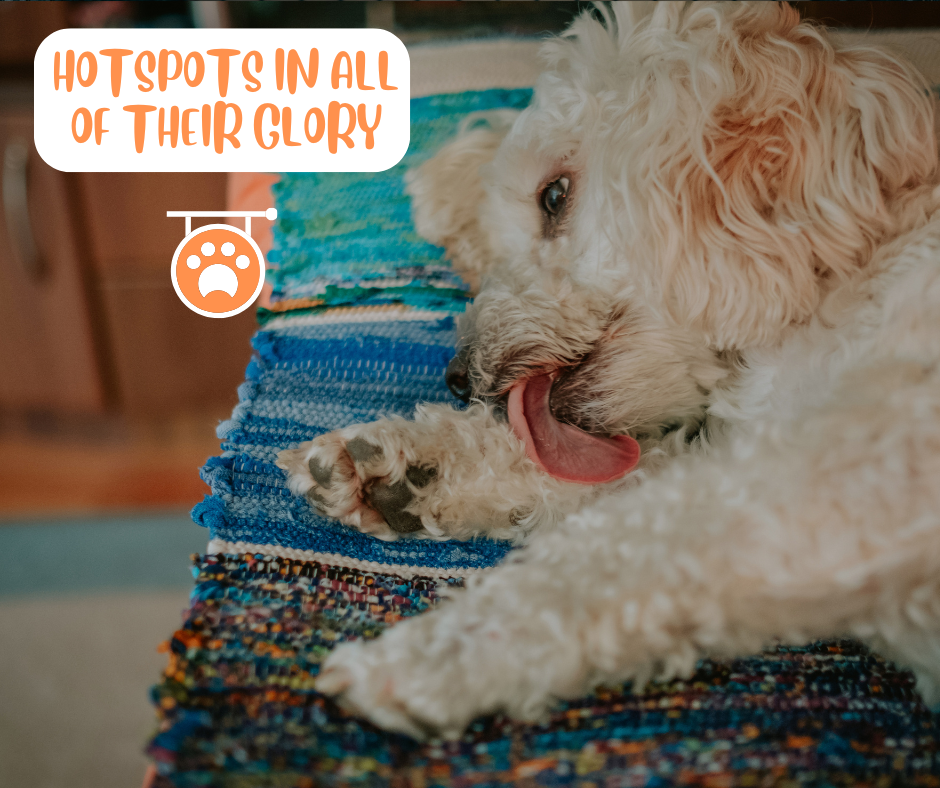 You know what a hotspot looks like right? It’s red, and probably wet because your dog has been chewing at it. And if you put your hand on it, it’s warm.
You know what a hotspot looks like right? It’s red, and probably wet because your dog has been chewing at it. And if you put your hand on it, it’s warm.
Thus, it’s called a hotspot.
But if you go to the regular Veterinarian, they’re going to say “oh my gosh there’s infection! Oh my goodness, we have to do antibiotics in the whole body, we have to do antibiotics on the spot, blah, blah blah!”
Note they hardly ever wonder, “Well, why is there a hotspot in the first place?”
These days they might give some of those medicines that stop itching, either an injection of c5t0p0in5 or a prescription of ap4q63l, or better both. (Can you say cha-ching?)
So, let’s first talk about what to do at the site of the hotspot. Then let’s figure out what could possibly have been causing it so you can get to the bottom of the scenario and hopefully avoid it in the future.
First, your vet is not 100% wrong when they say that there’s infection. It’s just that putting an antibiotic in the entire body when you have a little 3 in. area that is infected is excessive. Hot spots are typically a minimized, localized, and superficial infection.
And why is it infected? Because somebody has these tiny little nibbler teeth and gets a little itchy and goes nibble nibble nibble nibble nibble nibble, and they break open the skin. Think of a little kid with a really itchy mosquito bite. They can’t leave it alone. They self mutilate because pain is less annoying than itchiness.
And in all of that nibbling and scratching, we have broken open the blood vessels in the outer part of the skin. And there’s a tiny little bit of blood, with a big inflammatory reaction. This is how the body heals. It can heal itself, believe it or not.
So if your precious baby has a hotspot somewhere on the body, let’s clip the hair in the area. Wash it! Seriously, wash it with soap and water! “The solution to pollution (infection) is the dilution (soap and lots of water).”
If there’s a little local infection, wash it. Multiple times a day. Imagine if your two legged child fell down on the sidewalk and got a little bit of road rash. What would you do? You would wash it. Dry it. Then you might put a little bit of topical antibiotic ointment on it. Perfect.
Let’s put that on your dog.
Sure, you can use aloe, you can use coconut oil, you can use those antibiotic ointments that are made for humans that are totally safe for dogs as well. In most cases, it’s more a matter of keeping it clean and dry.
Sometimes you have to do something terrible like use a doughnut or a lampshade around your dog’s neck so he can’t get at it and itch it.
And this really does tend to be a dog thing. Very rarely do cats get hotspots. This is a dog thing.
In some cases, if you need it to dry out faster, you can do apply a powder of bentonite clay after washing. It’s actually sold as a face mask for women, but be sure the only ingredient is that: bentonite clay.
Like magic, most of these hot spots go away in a couple of days. Still, even with my approach, you’ll see that all we’ve done is treat the symptoms here. We haven’t done anything to figure out the cause.
There’s a list of things that could contribute and this is where I help people get to the bottom of ANY condition. For hotspots:
- It could be pollen. Which means we need to be giving frequent baths. And if you’re worried about bathing frequency, I wrote a post about that.
